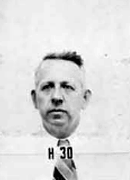Charles Donald Shane was an American astronomer and personnel director at the Berkeley Rad Lab and Los Alamos during the Manhattan Project.
Shane received his bachelor’s degree in Astronomy from the University of California, Berkeley, in 1915. Five years later, he earned his Ph.D. in Astronomy from Berkeley. His thesis focused on the spectra of carbon stars.
In 1917, Shane married Ethel Haskett, who worked as an observatory secretary. She died in January 1919, two weeks after giving birth to their son Charles. In 1920, Shane married Mary Lea Heger, who also studied astronomy at the University of California, Berkeley.
After receiving his doctorate, Shane began to teach at Berkeley, first in the Mathematics Department and later in the Astronomy Department, where he became chairman in 1941.
During World War II, Ernest Lawrence asked Shane to serve as an assistant director of scientific personnel for the Radiation Laboratory at Berkeley. General Leslie Groves then asked Shane to take up the same position at Los Alamos. While at Los Alamos, Shane witnessed the Trinity test.
After the war, Shane became the director of the Lick Observatory of the University of California, where he worked to count external galaxies and study their distribution. Shane held this post from 1945 until 1958, and remained a member of the University of California faculty until his retirement in 1963.
Shane published many papers during his career, and was elected to the American Philosophical Society in 1955 and the National Academy of Sciences in 1961. The 120-inch telescope at the Lick Observatory, which was funded and built during Shane’s directorship, was named the C. Donald Shane telescope in his honor.
Shane died on March 19, 1983, at the age of eighty-seven.





